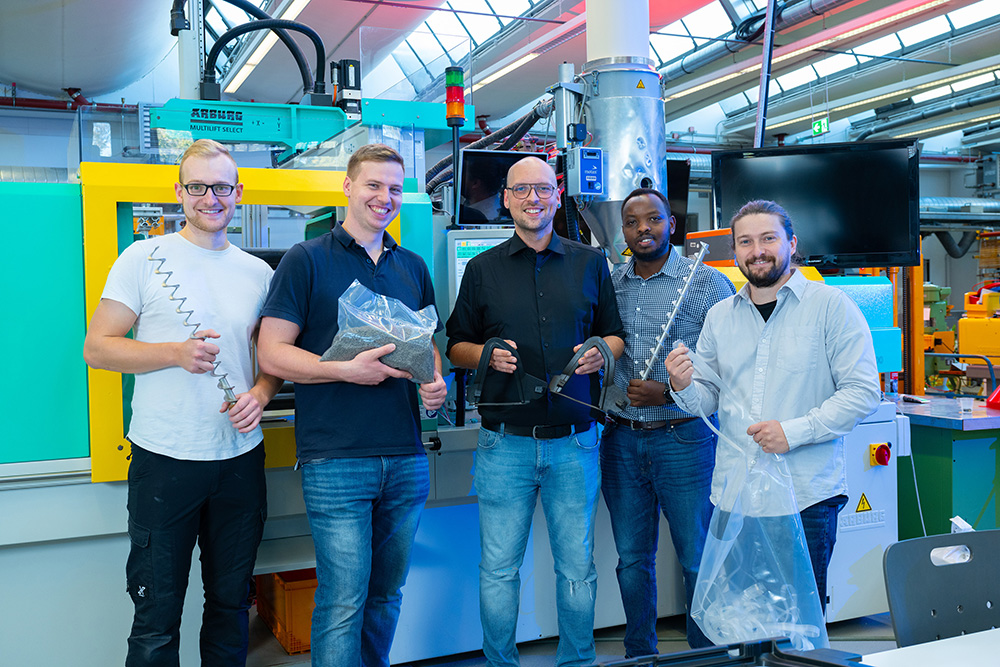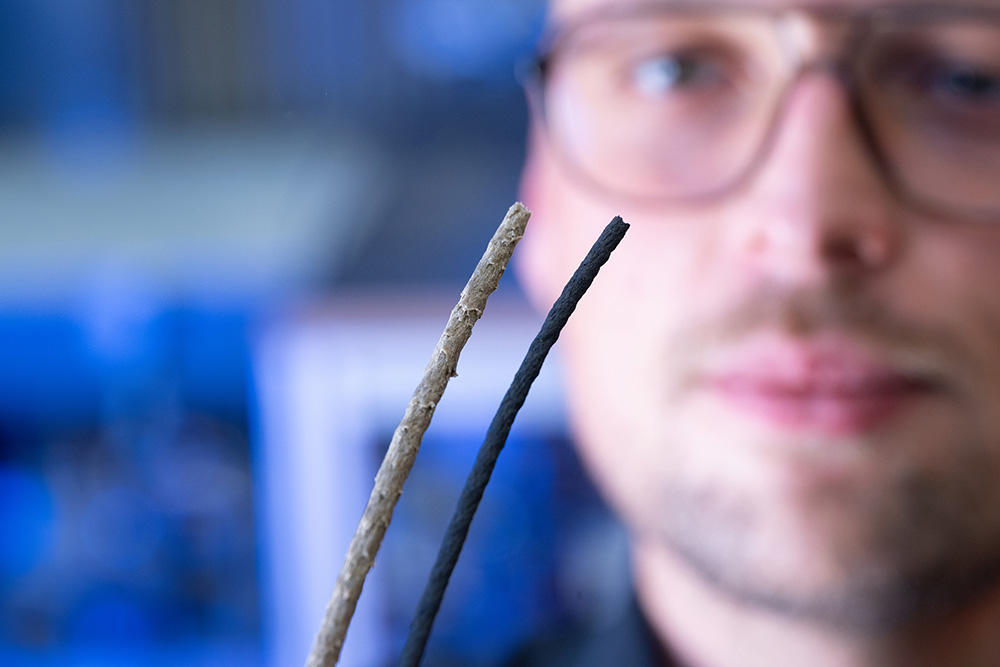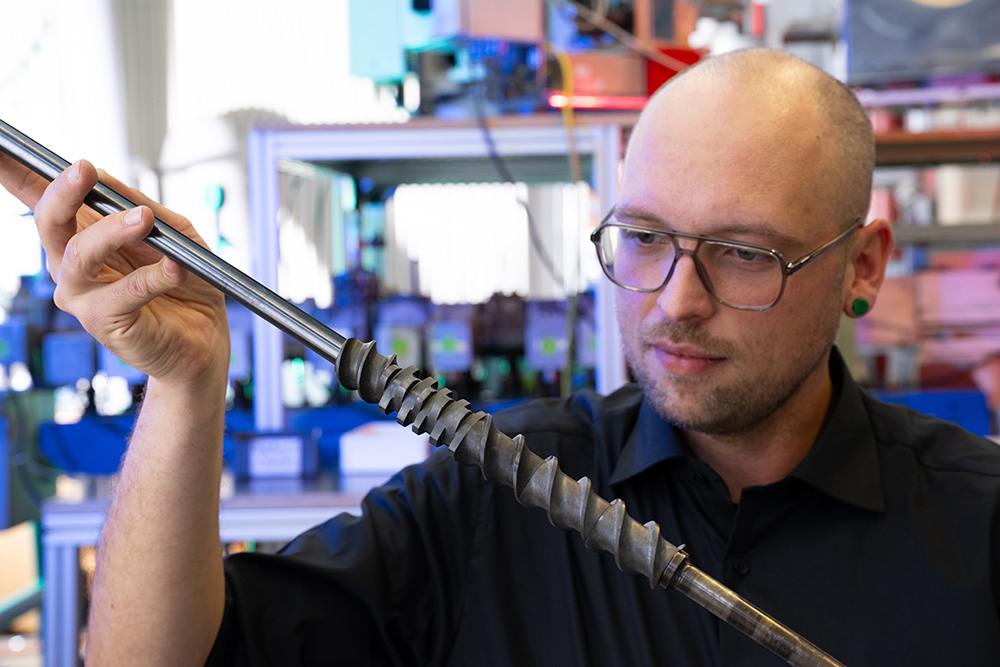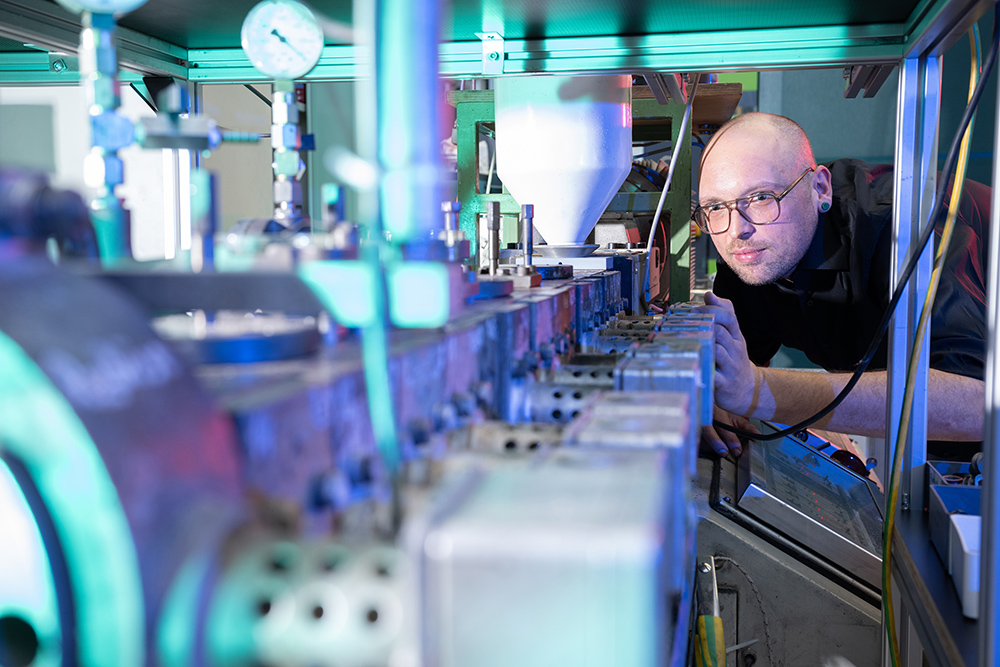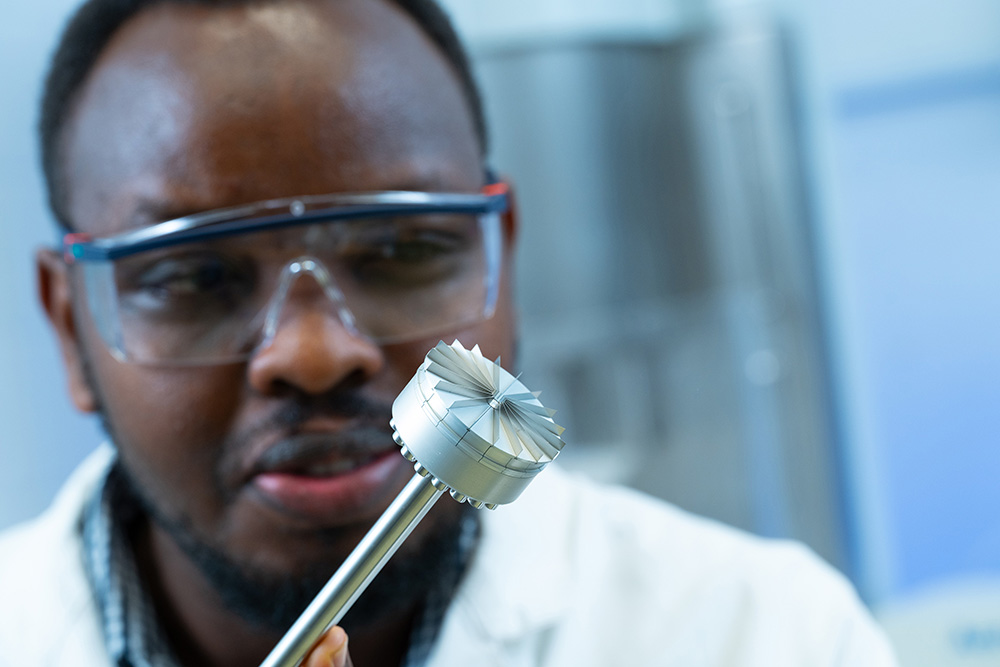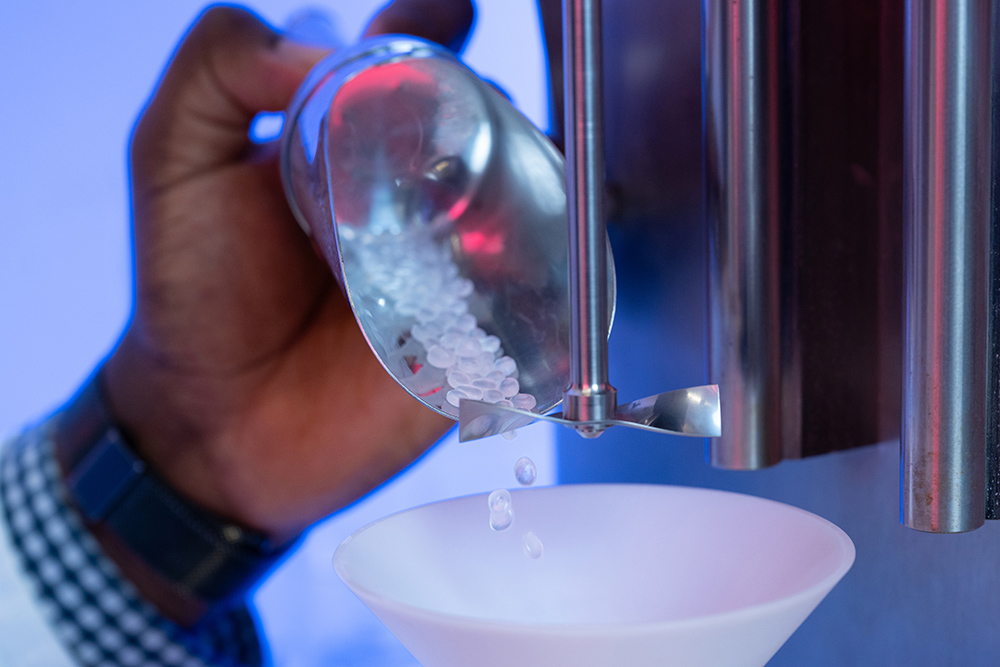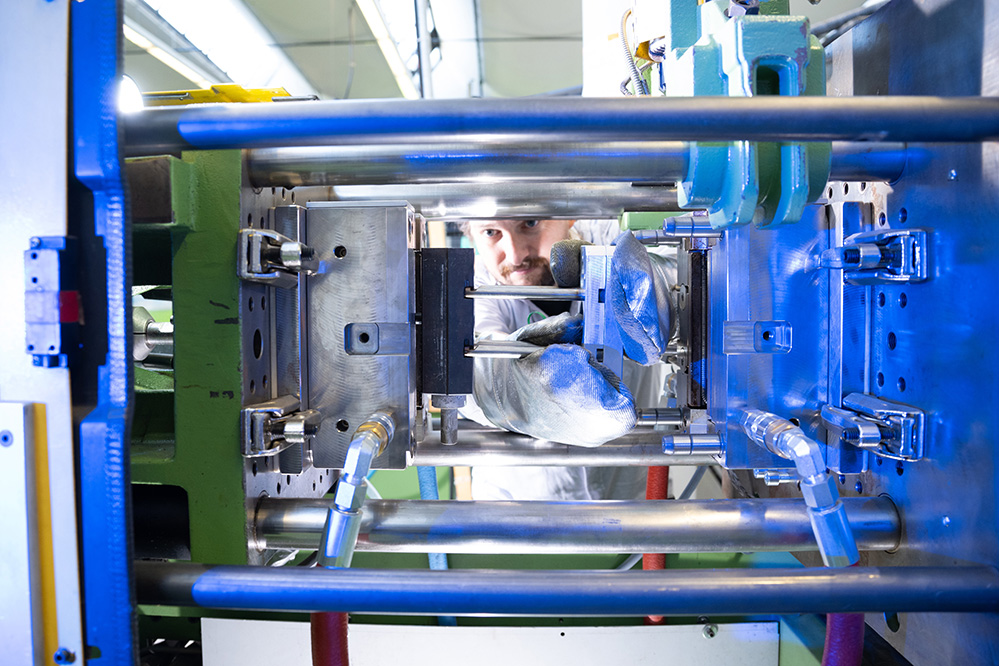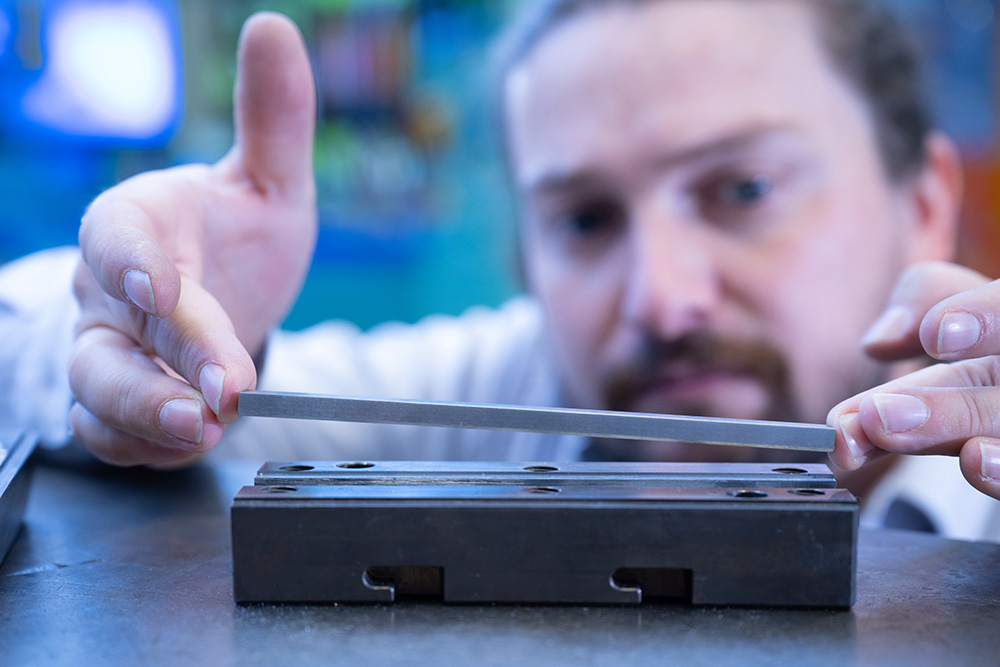Sustainable plastics technology
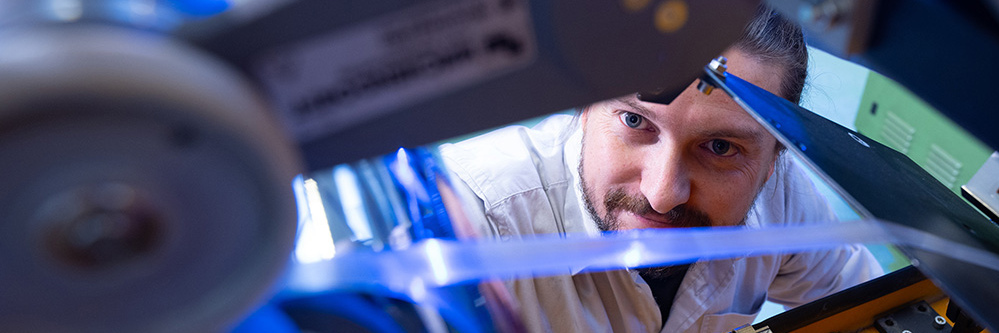
When they hear the word “plastic”, many people nowadays think in the first instance of plastic waste. Yet plastic is so much more: without it, there would be no touchscreens, mobile phones, LED lighting or, during the coronavirus pandemic, no FFP2 masks or rapid development of vaccines. In the frame of several projects, teams of young scientists led by Professor Jürgen Wieser at h_da’s Faculty of Mechanical and Plastics Engineering are showing just how sustainable and environmentally friendly plastics technology can be. The balancing act between practical relevance and basic research is proving successful.
By Astrid Ludwig, 6.11.2024
This used to be the door trim of a car. Now, all that is left are small, shredded, brown-grey crumbs – brown-grey because they are largely composed of flax. Natural fibre-reinforced plastics such as flax/polypropylene have been replacing petroleum-based plastics in the automotive industry and aircraft construction for many years, primarily for interior fittings. “The material is light and stable,” explains Heiko Hofmann, research assistant at the Faculty of Mechanical and Plastics Engineering. The “organic sheets” can also be recycled. Sounds good at first, but processing them is challenging, says Hofmann.
When it comes to the recycling of natural fibres, there is a catch – and you can smell it. “Flax has its own inherent and very distinctive smell,” says Hofmann, letting us sniff the bag of shreds to prove it. The material emits a strong scent of wood and smoke. While this might be a quality criterion for whiskey, an odour reminiscent of a campfire is undesirable inside a car – and not permitted either. What’s more, the fibre-reinforced material demonstrates poor flowability, making it almost impossible to process by means of injection moulding, the method commonly used in plastics engineering.
Successful formula
Heiko Hofmann and his team of staff and students have spent two years working on these problems within a research project. With financial support of around €212,000 from the Central Innovation Programme for SMEs (ZIM) of the Federal Ministry for Economic Affairs and Climate Action (BMWK) and in collaboration with Graupner GmbH & Co. KG, a company specialised in the production of plastic products, they have developed an innovative technique for processing the recycled natural fibre material.
Hofmann, who completed an apprenticeship as an industrial mechanic and worked his way up from secondary modern to university, did not give up. He added an entrainer to the shredded material, which was filtered out again with a vacuum in the downstream processing stage. By means of “flow improvers”, it was possible to obtain a solid strand of recyclate from the irregularly shredded material, which can be processed into a homogeneous and above all low-odour granulate.
“We have even received approval from a test institute,” reports Hofmann. “The process and the formula are ready to go.” The partner company can use h_da’s formula to develop new automotive components. For Professor Jürgen Wieser from the Institute of Plastics Technology at h_da, who is supervising the project, this does not just confirm the capability of a university of applied sciences. It is also “a success and a contribution to greater sustainability and the use of high-quality recycled materials.”
Always the right dose
As is so often the case, the right dose is the critical factor. The ingredients need to be in a specific ratio to each other. Plastic is usually produced in continuous processes, where several material streams flowing together must be balanced in such a way that a homogeneous product is created. Unlike in baking, the individual constituents are not weighed individually and added to the mixer one after the other. The composition of the mixture must be 100% correct at all times because otherwise the composition of the product during the manufacturing process would also fluctuate. Powdery raw materials are already a challenge, but regrind, fibres, or flakes such as shredded film, like typically occur in recycling processes, are particularly difficult, explains Ivan Kibet, research assistant at the faculty and doctoral student at h_da’s Doctoral Centre Sustainability Sciences.
But what exactly happens during dosing and why do supposedly identical raw materials sometimes behave differently? This is a question that almost all manufacturers are obliged to grapple with – not only in the plastics industry but also in the construction, automotive, food and pharmaceutical sectors. “Precise, fluctuation-free dosing in continuous processes is important for everyone,” says Kibet. Colour settings in the automotive industry must always be identical, a component’s mechanical properties must remain constant, drugs must have the desired effect and batteries must contain the correct amount of flame retardant. Dosing errors can lead to costly, environmentally harmful rejects, cause expensive production downtime or increase the risk of recalls that pose a threat to consumer trust.
“The practical experience is there, but an understanding of how everything fits together is lacking”
This is one reason why 16 companies from industry and GVT (Forschungs-Gesellschaft Verfahrens-Technik e. V.), a non-profit association that supports process engineering research, are participating in the “DOSISPEC” project. The Federal Ministry for Economic Affairs and Climate Action is supporting the project with external funds of around €240,000 from the Industrial Collective Research (IGF) programme. The aim is to define specifications for the flow and dosing behaviour of certain bulk materials. In many companies, know-how about correct dosing is based on many years’ practical experience. If machines, materials or staff change, however, it can become difficult. “The practical experience is there, but an understanding of how everything fits together is lacking,” says Professor Wieser. The six-strong project team wants to change this.
Here, Ivan Kibet and his team are a bit like Sherlock Holmes. They inspect the companies’ equipment on site, test the rheology – the flow properties of the bulk materials – in the laboratory, conduct dosing tests and examine, among other things, the influence of humidity or storage, for example, on flow and dosing behaviour. This should lead to a kind of manual with models and recommendations on possible specifications and suitable laboratory tests for the industrial partners so that they can manufacture their products in a more predictable and environmentally friendly way.
Annoying black dots
Philipp Seeger, research assistant at the Faculty of Mechanical and Plastics Engineering, Manager of h_da’s Research Centre for Materials and Process Engineering and doctoral student at Clausthal University of Technology, is dealing with a further fundamental problem in plastics processing. His research centres on something called “specks”. These are small, annoying black dots that as impurities or flaws in transparent plastics repeatedly cause trouble. The particles that form during the further processing of the plastic in the injection moulding machine or extruder are particularly problematic. Extruders are conveying devices that use rotating screws, which resemble gigantic screws, to transform the solid material into a melt and press it evenly into shape under high pressure and temperature.
How these specks develop is still not yet fully explained. At first, it was thought that the melt sticks to the hot metal surfaces – like a sausage in a hot frying pan. However, the research team discovered that in reality things are far more complex. At temperatures of around 300 degrees, the plastic, for example polycarbonate, settles in wafer-thin layers on the walls of the machine. These layers are initially a few nanometres thick (for comparison, a human hair is five to ten thousand times thicker). These deposits then accumulate. At some point, pieces can detach and end up in the product, making it unusable. “It’s a very old problem, but so far nobody knows exactly what happens when the layer builds up and then detaches,” adds Wieser. “Until now, there have only been trial-and-error solutions, without really knowing why any particular one of them helps.” Attempts to counteract the black dots by applying surface coatings are common in practice, but finding a solution usually happens by chance and is in some cases very arduous. “And the problem recurs again and again,” reports Seeger. Reject rates can be up to five percent and sometimes even higher. The material cannot be recycled because of the impurities. “Both economically and environmentally, this is a serious issue,” he says.
Collaboration with Clausthal University of Technology and numerous companies
Together with Clausthal Centre for Material Technology (CZM) at Clausthal University of Technology, which specialises in surface physics, the research group in Darmstadt was able to demonstrate interactions between the material and the metal wall of the machines. Iron ions diffuse into the plastic and alter it, reports Philipp Seeger. “We are now taking a closer look at the process, reproducing flow conditions and examining how deposits build up over time.” To do this, they have developed a hybrid of an injection moulding machine and an extruder, which is additionally fitted with a camera system and a laser. The aim is to detect the specks in the melt and then document them. “We will then see exactly whether something changes, and if so what, when we adjust the parameters.” Thanks to the Federal Government’s Industrial Collective Research (IGF) programme, numerous partners from the plastics sector, the metalworking industry and coating companies are also on board. Around €500,000 will be available for this basic research up until 2026. Seeger hopes that the laboratory results will help to develop targeted solutions in practice. This could then save significant resources.
The three projects show how plastics research can contribute to sustainability. The h_da researchers are convinced: “Plastics are currently heavily criticised, but we can’t do without them. In our projects, we are working to lower waste rates, optimise manufacturing and make the whole process more environmentally friendly from start to finish.”
Contact the h_da science editorial team
Christina Janssen
Science Editor
University Communication
Tel.: +49.6151.533-60112
Email: christina.janssen@h-da.de
Translation: Sharon Oranski
Photography: Markus Schmidt
